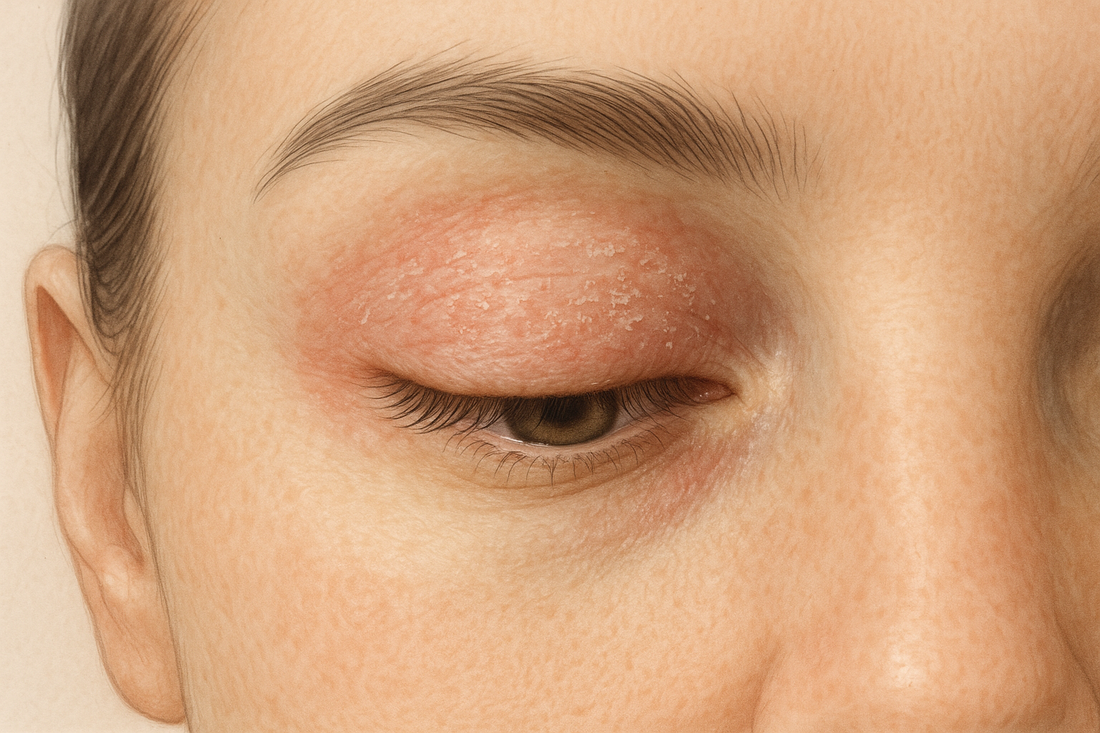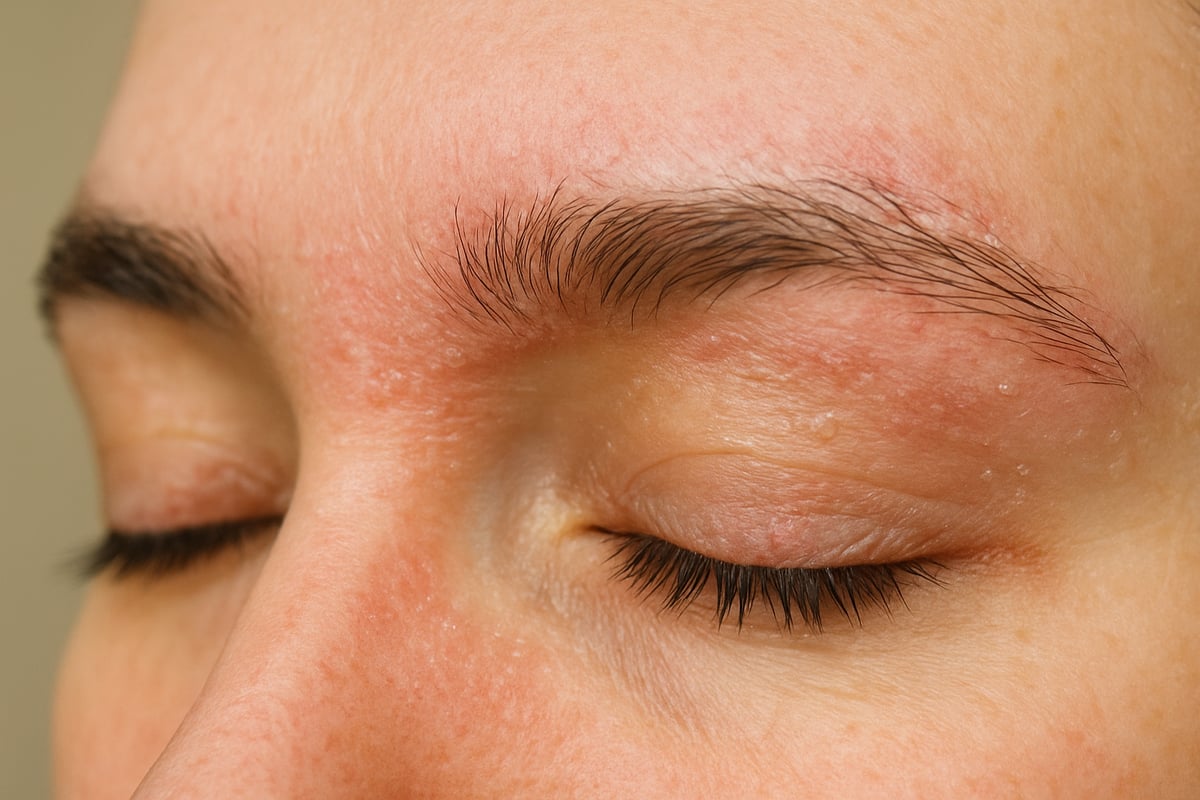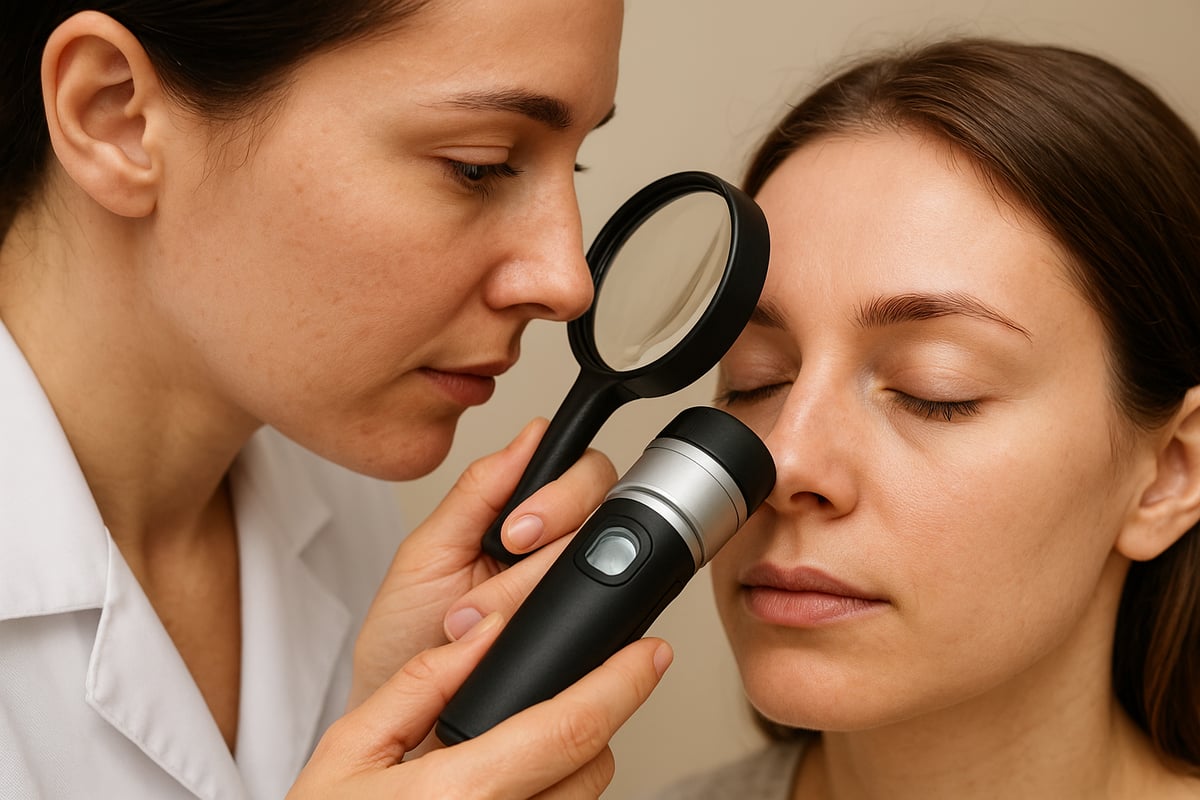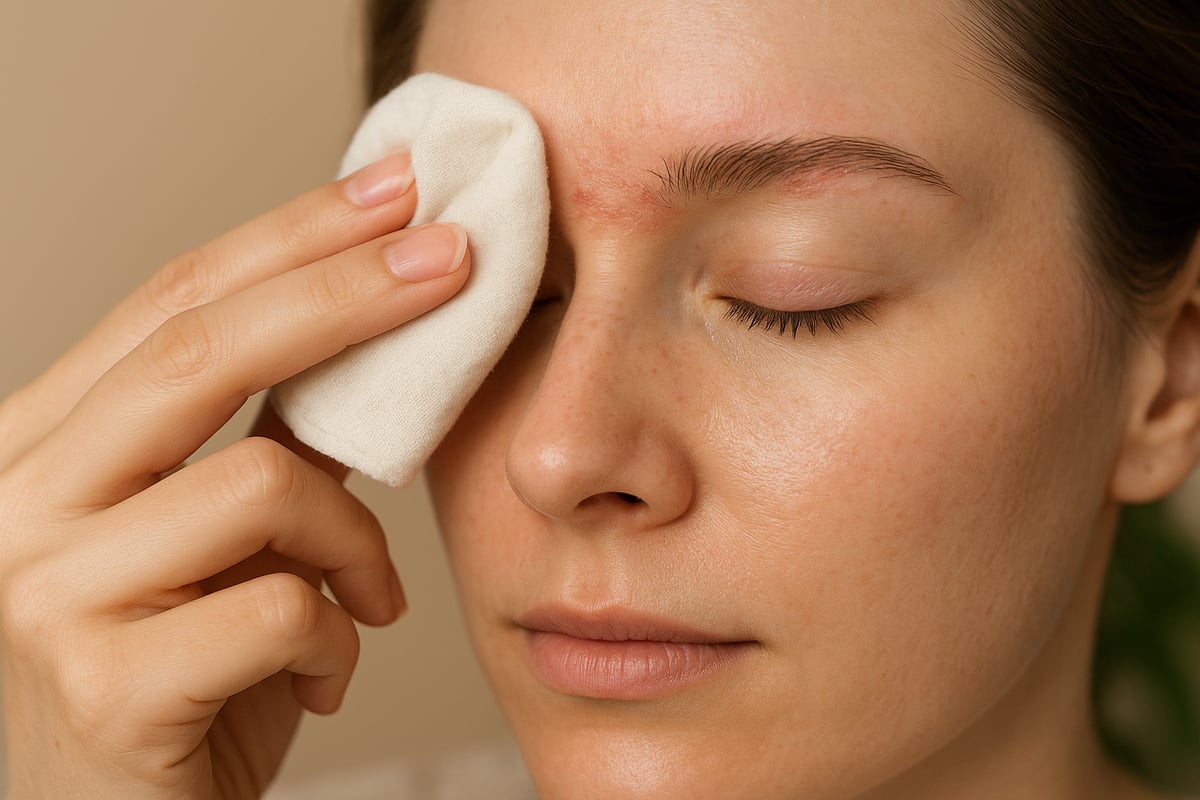
Eczema in Eyebrows Guide: Expert Solutions for 2025
Are you tired of battling itchy, flaky skin around your eyebrows? You are not alone. Cases of eczema in eyebrows are rising in 2025, causing daily discomfort for many.
This guide brings together the latest dermatologist advice, real solutions, and proven products for managing eczema in eyebrows. We aim to help you restore your skin's health and regain confidence.
Inside, you will discover what causes eyebrow eczema, how to recognise symptoms, and the best ways to treat and prevent flare-ups. Learn about new treatments, daily care routines, and expert prevention tips. Take the first step toward relief and comfort, guided by science and experience.
Understanding Eyebrow Eczema: Causes and Symptoms
Do your eyebrows feel itchy, flaky, or red? You may be dealing with eczema in eyebrows, a condition that’s affecting more people every year. Understanding what makes this skin issue unique is the first step towards finding relief.

What Is Eyebrow Eczema?
Eczema in eyebrows describes inflammation of the skin in the eyebrow region, causing itching, redness, and flaking. Dermatologists classify it into types such as atopic dermatitis, seborrheic dermatitis, and contact dermatitis. Each type has subtle differences, but all can impact your comfort and confidence.
Did you know that up to 15 percent of people with eczema experience facial involvement, including the eyebrows? According to Eczema prevalence statistics, facial eczema is becoming more common, especially in adults.
Unlike dandruff, which typically affects the scalp, or psoriasis, which presents as thicker silvery scales, eczema in eyebrows often produces a finer, more persistent flaking. This can make it easy to mistake for other conditions, so knowing the distinctions is important.
Common Causes in 2025
Several factors can trigger or worsen eczema in eyebrows. Genetics play a big role, especially if you have a family history of allergies or eczema. Environmental factors like air pollution and rapid weather changes can make symptoms flare up.
Skincare and cosmetic products may contain allergens or harsh chemicals that irritate sensitive eyebrow skin. Everyday stress and immune system changes are also common triggers. Hormonal fluctuations, such as those experienced during puberty, pregnancy, or menopause, can make eczema in eyebrows more unpredictable.
Keeping track of these triggers can help you better manage flare-ups and avoid unnecessary discomfort.
Recognising Symptoms
Spotting eczema in eyebrows early can make a big difference. Look for redness and scaling directly in the eyebrow area. Flaking is common, and you might notice intense itching that feels almost impossible to ignore.
In more severe cases, swelling or crusting can develop, and some people even experience thinning or loss of eyebrow hair. Here’s a quick overview:
|
Symptom |
Description |
|---|---|
|
Redness |
Inflamed, pink or red skin in the eyebrows |
|
Flaking |
Noticeable dry, peeling skin |
|
Itchiness |
Persistent urge to scratch |
|
Swelling |
Puffiness or tenderness in severe cases |
|
Hair Thinning |
Eyebrow hairs falling out or appearing sparse |
Real-life stories often highlight the frustration of dealing with eczema in eyebrows. One patient described the embarrassment of visible flakes at work, while another shared how their symptoms improved after identifying a hidden cosmetic allergen.
When to See a Dermatologist
If your eczema in eyebrows starts to ooze, develops a yellow crust, or shows signs of infection, it’s time to seek professional help. Persistent symptoms that do not improve with home care may require prescription treatments.
Pay special attention if the skin changes begin to affect your vision or cause discomfort around your eyes. A dermatologist can offer targeted advice, run tests, and help you find a personalised solution for eczema in eyebrows.
Diagnosing Eczema in Eyebrows: Expert Insights
Struggling to pinpoint the cause of irritation or flaking in your brow area? Diagnosing eczema in eyebrows requires a careful and expert approach, blending traditional methods with new technology. Dermatologists use a combination of examinations, patient stories, and specialised tests to ensure your symptoms are accurately identified.

How Dermatologists Diagnose
When you visit a dermatologist for eczema in eyebrows, the process begins with a detailed visual exam. The doctor assesses redness, scaling, and distribution of the rash. They also ask about your health history, recent product use, and any changes in your routine.
Special tools like dermatoscopy allow experts to view skin patterns up close. Sometimes, a gentle skin scraping is performed to rule out fungal infections. If your symptoms seem linked to allergies, patch testing may be recommended. Learning from others is powerful too, and reviewing Real-life eczema case studies can help you understand what to expect during diagnosis.
Differentiating from Other Conditions
Eczema in eyebrows can mimic other skin disorders, making diagnosis tricky. Seborrheic dermatitis often overlaps with eczema in this area, but usually includes greasy scales and affects other oily zones. Psoriasis, on the other hand, presents with thicker, silvery plaques.
Fungal infections may cause similar redness and flaking, but tend to itch more intensely and spread differently. Rosacea and allergic contact dermatitis can also appear near the brows, so dermatologists look for telltale signs unique to each condition. By comparing these features, your doctor can confidently confirm if you are facing eczema in eyebrows.
The Role of Allergy Testing
If you have persistent eczema in eyebrows, allergy testing becomes crucial. Dermatologists may use patch tests to check for delayed reactions to skincare ingredients or eyebrow makeup. Prick tests can identify immediate allergies, especially if you notice swelling or burning after product use.
Common culprits for eczema in eyebrows include nickel in tweezers, fragrances, and preservatives found in brow gels or creams. By identifying triggers, you can avoid future flare-ups and find safer alternatives for your routine.
Latest Diagnostic Tools (2025 Update)
The landscape of diagnosing eczema in eyebrows has evolved rapidly. AI-powered skin analysis apps now allow for high-resolution imaging and pattern recognition, helping both patients and professionals spot subtle changes early.
Teledermatology has expanded access, letting you consult experts remotely with clear photos or live video. Recent studies highlight advancements in non-invasive diagnostics, such as skin barrier sensors and digital patch tests. These tools make getting an accurate diagnosis for eczema in eyebrows faster, more precise, and less stressful.
Step-by-Step Solutions: Treating Eyebrow Eczema
Battling eczema in eyebrows can feel overwhelming, but relief is absolutely within reach. Let’s walk through a proven, step-by-step approach designed for real-life results in 2025. Each strategy builds on the last, creating a routine that soothes, heals, and protects delicate eyebrow skin.

Step 1: Identifying and Avoiding Triggers
The first step to managing eczema in eyebrows is playing detective—discovering what sets off your flare-ups. Common eyebrow irritants include fragrances, preservatives, and certain dyes found in brow gels or pencils. Environmental factors like cold winds or dry indoor air can also aggravate symptoms.
Keep a daily skin diary. Note when symptoms worsen and what products or foods you used. Stress, hormonal shifts, and even a sudden change in weather can impact eczema in eyebrows. By tracking these patterns, you’ll spot hidden triggers and avoid repeat offenders.
If you suspect a product is to blame, stop using it immediately. Swap to gentle, hypoallergenic alternatives and observe if your skin calms down. This step lays the foundation for long-term relief from eczema in eyebrows.
Step 2: Gentle Cleansing and Skincare
Cleansing is vital, but it must be gentle. Use fragrance-free, hypoallergenic cleansers specifically made for sensitive skin. Avoid foaming agents, harsh scrubs, or exfoliants, as these strip natural oils and worsen eczema in eyebrows.
Always wash your face with lukewarm water, not hot. Pat the brow area dry with a soft towel—never rub. Follow up with a lightweight, non-comedogenic moisturiser. Look for ingredients like ceramides or hyaluronic acid, which help restore the skin’s barrier.
A simple, consistent routine keeps the skin around your eyebrows calm and reduces the chance of irritation. Over-cleansing or frequent product switching can disrupt progress, so stick to what works for eczema in eyebrows.
Step 3: Topical Treatments and Medications
There are several effective options for treating eczema in eyebrows, ranging from over-the-counter creams to prescription solutions. Hydrocortisone cream is a common starting point, but it should be used sparingly and only for short periods to avoid skin thinning.
For persistent cases, dermatologists may recommend topical steroids or non-steroidal options like tacrolimus or pimecrolimus. New non-steroidal creams in 2025 offer targeted relief with fewer side effects, especially for sensitive facial skin. If seborrheic dermatitis overlaps with eczema in eyebrows, antifungal creams may also be prescribed.
Want to see how real patients respond to these treatments? Check out this Eyebrow eczema trial progress for insights into early symptom changes and practical results. Always consult your healthcare provider before starting any new medication.
|
Treatment Type |
Use Case |
Notes |
|---|---|---|
|
Hydrocortisone Cream |
Mild, short-term symptom relief |
Limit use on face |
|
Calcineurin Inhibitors |
Sensitive, steroid-resistant |
Prescription only |
|
New Non-Steroidal Creams |
Latest options, fewer side effects |
Ask dermatologist |
|
Antifungal Creams |
Seborrheic overlap present |
Address yeast triggers |
Step 4: Natural Remedies and Lifestyle Adjustments
Lifestyle tweaks can make a real difference in managing eczema in eyebrows. Some people find relief with oatmeal compresses—simply soak oats in water, strain, and apply the liquid to your brows. Aloe vera gel and coconut oil are also soothing for inflamed skin.
Diet plays a part too. Omega-3 fatty acids and probiotics may support skin health, so consider adding foods like salmon, flaxseed, and yogurt to your meals. Managing stress is crucial, as anxiety often triggers eczema in eyebrows. Try mindfulness, meditation, or gentle exercise to keep stress at bay.
Remember, natural remedies work best when combined with medical treatments and a consistent care routine. Always patch test new natural products to avoid unexpected reactions.
Step 5: Advanced Therapies and Professional Treatments
If standard measures are not enough, advanced therapies can bring relief. Light therapy (narrowband UVB) is sometimes used for stubborn eczema in eyebrows, targeting inflammation without medication. Biologics like dupilumab or tralokinumab are reserved for severe, unresponsive cases, and they work by calming the immune system’s overreaction.
Some clinics offer microneedling or regenerative treatments to support skin repair, though these should only be pursued under medical supervision. Discuss these options with your dermatologist, especially if eczema in eyebrows affects your confidence or quality of life.
Professional treatments are not for everyone, but they represent hope for those with persistent symptoms. Stay open to new solutions as research continues to advance in 2025.
Step 6: Daily Eyebrow Care Routine
Consistency is your secret weapon for keeping eczema in eyebrows under control. Moisturise twice daily with a product suited for sensitive skin. When grooming, use sanitised tools and avoid eyebrow waxing or harsh dyes.
Protect your brows from sun and pollution by wearing a wide-brimmed hat or using mineral sunscreen. If you use makeup, choose products labeled “non-comedogenic” and remove them gently at the end of the day.
Here’s a sample daily routine for eczema in eyebrows:
-
AM: Gentle cleanse, moisturise, apply sunscreen
-
PM: Cleanse, moisturise, avoid heavy styling products
-
Weekly: Check for new irritation, adjust products as needed
By following these steps, you can restore comfort and confidence, making eczema in eyebrows a manageable part of your daily life.
Choosing the Right Products for Eyebrow Eczema
Finding the right products for eczema in eyebrows can feel like navigating a maze. With sensitive skin, even a single ingredient can trigger discomfort. Choosing carefully means fewer flare-ups and more confidence in your daily routine.
Ingredients to Seek and Avoid
The first step in managing eczema in eyebrows is understanding what goes into your products. Skin in this area is thin and prone to irritation, so ingredient lists matter.
Table: Good vs. Bad Ingredients
|
Seek Out |
Avoid |
|---|---|
|
Ceramides |
Fragrances |
|
Hyaluronic acid |
Alcohols |
|
Panthenol |
Parabens |
|
Glycerin |
Lanolin |
Look for moisturisers with ceramides or hyaluronic acid. These support the skin barrier and help keep eczema in eyebrows under control. On the flip side, fragrances and parabens are common culprits behind irritation. Always check labels for hidden triggers.
Choosing gentle, minimal-ingredient products gives your skin the best chance to heal. When in doubt, patch test first.
Top Dermatologist-Recommended Products (2025)
Dermatologists recommend simple, science-backed options for eczema in eyebrows. Hypoallergenic cleansers are a must. Creams like those with ceramides or panthenol offer hydration without harshness.
Popular picks in 2025 include fragrance-free cleansers and barrier creams proven to soothe inflammation. Over-the-counter hydrocortisone can help mild cases, while prescription options may be needed for stubborn eczema in eyebrows.
Case example: One patient switched to a gentle, ceramide-rich moisturiser and saw major improvement within weeks. Always consult your dermatologist for tailored advice, especially if standard products do not bring relief.
Waipu Extracts: Natural Mānuka Solutions for Eyebrow Eczema
Natural solutions are gaining attention for eczema in eyebrows, especially for sensitive or steroid-resistant skin. Waipu Extracts’ Full Spectrum Mānuka Extract is a standout, thanks to Mānuka’s natural anti-inflammatory and antimicrobial power.

This extract is suitable for delicate facial skin and is ethically sourced for purity. Many customers share stories of comfort and visible improvement after using it for eczema in eyebrows. Mānuka’s benefits come from unique plant compounds, making it a promising addition to your routine.
Want to understand the science? Learn why our Mānuka extract works and see how it can fit into your eczema care plan.
Patch Testing and Product Introduction Tips
Before adding a new product to your routine, patch testing is essential for anyone with eczema in eyebrows. Apply a small amount behind your ear or on your inner arm. Wait 48 hours and check for redness or itching.
Introduce only one new product every few weeks. This way, you can spot any reactions quickly and prevent unnecessary flare-ups.
Avoiding Common Eyebrow Product Mistakes
Many people with eczema in eyebrows unknowingly use harsh makeup, dyes, or removers that trigger irritation. Consider fragrance-free eyebrow gels or pencils made for sensitive skin.
Skip aggressive grooming and opt for gentle brushing instead. Your skin will thank you.
Preventing Flare-Ups: Long-Term Management Strategies
Managing eczema in eyebrows is not just about treating symptoms, but also about preventing flare-ups before they start. Consistency and self-awareness are your best allies on this journey to healthier skin.
Building a Sustainable Skincare Routine
A gentle skincare routine is the cornerstone for preventing eczema in eyebrows from recurring. Choose a mild, fragrance-free cleanser and use it twice daily. Moisturise immediately after washing to lock in hydration, focusing on lightweight, non-comedogenic formulas.
Adjust your routine with the seasons. In winter, opt for a richer moisturiser, while in humid months, lighter gels may suffice. Remember, sticking to a simple, consistent regimen helps your skin barrier stay resilient against eczema in eyebrows.
-
Cleanse with lukewarm water
-
Pat skin dry, never rub
-
Apply moisturiser within three minutes of washing
Environmental and Lifestyle Modifications
Environmental triggers are a major factor in eczema in eyebrows flare-ups. Pollution, pollen, and sudden weather changes can stress your skin. When outdoors, consider wearing a hat or using mineral sunscreen to shield your eyebrows.
Lifestyle habits matter too. Prioritise regular sleep, manage stress with mindfulness or gentle exercise, and keep your home air clean. For more on how global trends and environment impact eczema, see the Epidemiology of atopic dermatitis.
-
Use a humidifier in dry climates
-
Wash pillowcases frequently
-
Limit exposure to smoke and strong scents
Diet and Supplement Considerations
What you eat can influence eczema in eyebrows. Anti-inflammatory diets rich in omega-3 fatty acids, fruits, and vegetables may help reduce skin sensitivity. Some people benefit from probiotics, which support gut and immune health.
Vitamin D supplementation is also being explored for eczema in eyebrows, especially in those with limited sun exposure. Consult your healthcare provider before making significant dietary changes or starting new supplements.
|
Nutrient |
Potential Benefit |
|---|---|
|
Omega-3s |
Reduce inflammation |
|
Probiotics |
Support immune balance |
|
Vitamin D |
Enhance skin barrier |
Monitoring and Early Intervention
Stay attuned to your skin’s signals. Keeping a symptom journal helps identify patterns and triggers for eczema in eyebrows. Note changes in weather, products, diet, or stress levels alongside any flare-ups.
If you notice increased redness, itching, or flaking, act quickly. Early intervention with your established routine can often prevent a full-blown episode of eczema in eyebrows.
Community Support and Resources
You don’t have to manage eczema in eyebrows alone. Join online support groups or forums dedicated to eczema care for shared experiences and tips. These communities often provide emotional relief and practical advice.
Teledermatology services make expert help accessible, even from home. Connecting with professionals and peers empowers you to take charge of eczema in eyebrows and maintain long-term comfort and confidence.
Eyebrow Eczema in Special Populations: Children, Seniors, and Sensitive Skin
Managing eczema in eyebrows requires special attention for children, seniors, and those with particularly sensitive skin. Each group faces unique challenges, and understanding these differences is key to providing gentle, effective care that restores comfort and confidence.
Pediatric Eyebrow Eczema
Eczema in eyebrows often appears in infants and children, sometimes as early as a few months old. The skin here is delicate, making it more prone to redness, flaking, and irritation. Family history often plays a role, but environmental factors and allergies can trigger symptoms too.
When caring for children with eczema in eyebrows, gentle routines are essential. Use fragrance-free, hypoallergenic cleansers and moisturisers. Avoid harsh wipes, soaps, or scrubs. Pediatricians often recommend mild topical steroids or non-steroidal creams for short-term relief, but always under medical supervision.
Parents should monitor for signs of infection, such as yellow crusting or swelling, and avoid common irritants found in some baby wipes or lotions. Creating a symptom diary helps track triggers and progress. According to global trends in eczema prevalence, childhood cases are rising, so early intervention is vital.
Eyebrow Eczema in Older Adults
Older adults commonly experience eczema in eyebrows due to age-related skin thinning and reduced oil production. This can make the area more susceptible to dryness, irritation, and persistent flaking.
Adjusting treatment approaches is crucial. Choose ultra-moisturising, fragrance-free products and avoid alcohol-based cleansers. Seniors should be cautious with topical steroids, as their skin may be more fragile. Regular moisturising and gentle cleansing help maintain skin integrity and comfort.
Managing Eczema with Sensitive or Reactive Skin
For those with sensitive or reactive skin, managing eczema in eyebrows can feel like walking a tightrope. Even small amounts of fragrance, dyes, or preservatives can trigger flare-ups.
Opt for ultra-gentle products, such as those labeled for sensitive skin or specifically formulated for eczema. Allergen avoidance is crucial. Always patch test new products before full application, and introduce one product at a time to identify any reactions. Keeping the area protected from extreme temperature changes and pollution can also reduce irritation.
Gender and Ethnic Considerations
Eczema in eyebrows does not affect all genders or ethnicities equally. Studies show prevalence can vary, with certain groups experiencing more persistent or severe symptoms. Differences in skin structure and pigmentation may require tailored care, such as choosing products that do not cause discoloration or dryness in darker skin tones.
Understanding these nuances ensures everyone receives care suited to their skin’s unique needs, promoting better outcomes and comfort.
When to Seek Specialist Care
Sometimes, eczema in eyebrows does not respond to basic home care. If symptoms worsen, spread, or cause significant discomfort, it is time to consult a dermatologist or allergy specialist. Signs such as severe swelling, crusting, or suspected infection require prompt evaluation.
Multidisciplinary management may be needed for complex or treatment-resistant cases, especially in children or seniors. Early expert guidance helps prevent complications and supports long-term skin health.

